I don’t often play two-player games: my wife isn’t much of a gamer, so usually either I host a game night and have a few people over, or else I’m not playing anything. But there are times when a good two-player game is exactly what I’m looking for. In this series of “Table for Two” posts, I’ll share a few new(ish) two-player games I’ve been trying out lately.
 Draco Magi is a game designed by Richard Launius and Robert Burke, and will be on Kickstarter later this month. Here’s the story: the Dragon King is dead, and his two apprentices are competing for the title. You need to collect gems from various locations by sending your dragons—which of course leads to battles fought with tooth and claw and magic.
Draco Magi is a game designed by Richard Launius and Robert Burke, and will be on Kickstarter later this month. Here’s the story: the Dragon King is dead, and his two apprentices are competing for the title. You need to collect gems from various locations by sending your dragons—which of course leads to battles fought with tooth and claw and magic.
I received a prototype of the game to try out—it has a lot of the finished artwork but some of the card layout and details are still being tweaked, so keep in mind that the images here are not final.
The game is entirely card-based, with an interesting card-flipping mechanic that replaces dice-rolling, so the components are all cards: 54 Dragon cards, 40 Battle cards, 18 Advanced Battle cards, and 16 Battlefield cards. There’s also a first player marker—the one in my set was just a clear glass bead, but I don’t know what the final will be.
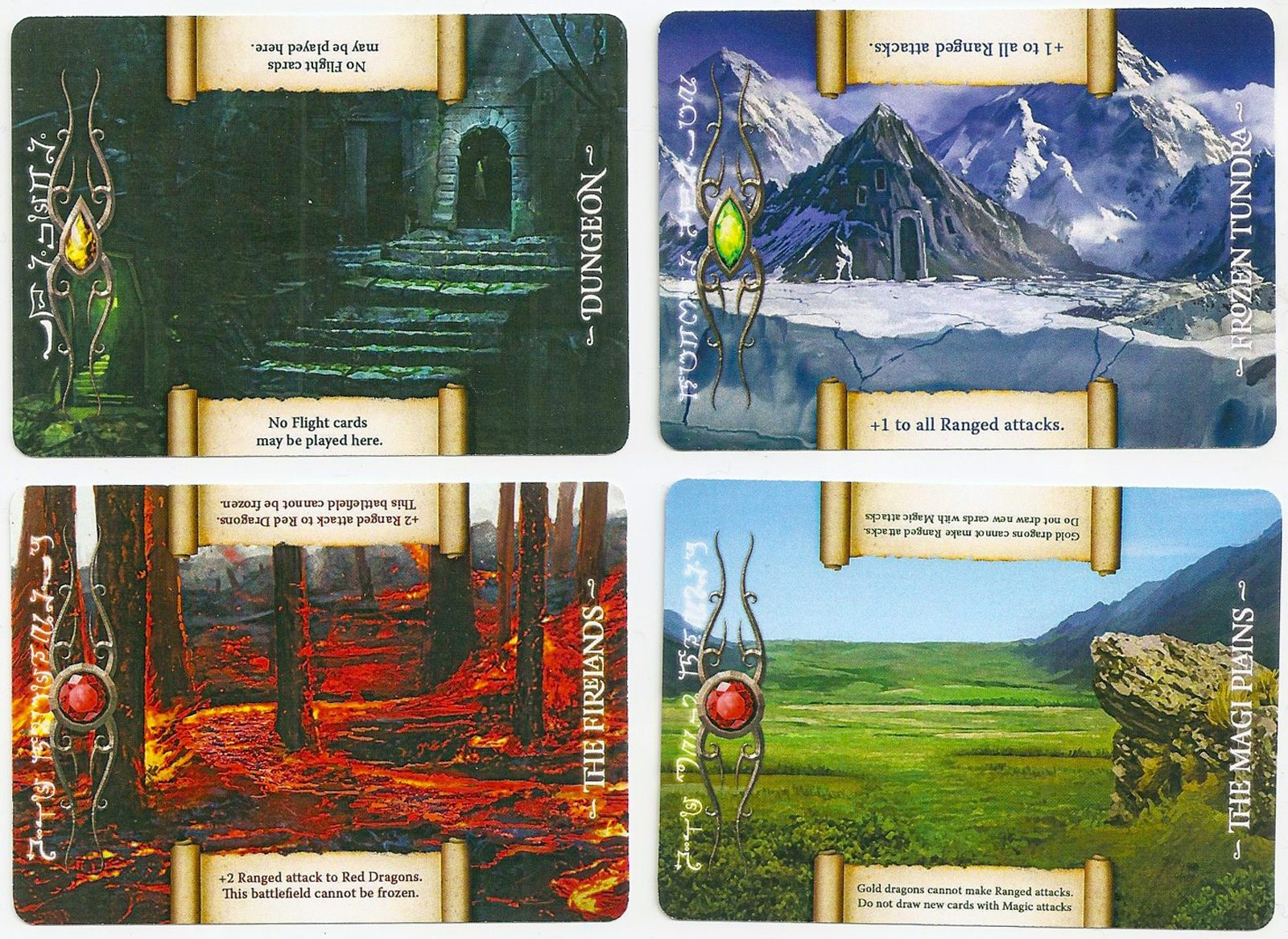
The artwork on the cards, by Kerem Beyit and Luis Francisco, looks like your traditional high-fantasy paintings, which is not to say they aren’t excellent. The dragons are impressively detailed, and the landscapes are beautiful. There’s a glyph font used for the abilities on the dragon cards, and the little graphic touches are nicely done, though some of the icons are a little small. I did have a complaint about the card layout, but Burke informed me that the cards are being rearranged based on feedback from playtesting, so it sounds like that should be taken care of.

How to Play
A PDF draft of the rules is available here, so I’ll just give a quick overview.
The goal of the game is to collect gems: you’ll need 3 of the same color, or 3 different colors, or any 4 gems to win the game.
Each player starts with two decks: Dragon cards and Battle cards (with two Advanced Battle cards shuffled in). Three Battlefield cards are laid out in the center. You each draw eight dragon cards.
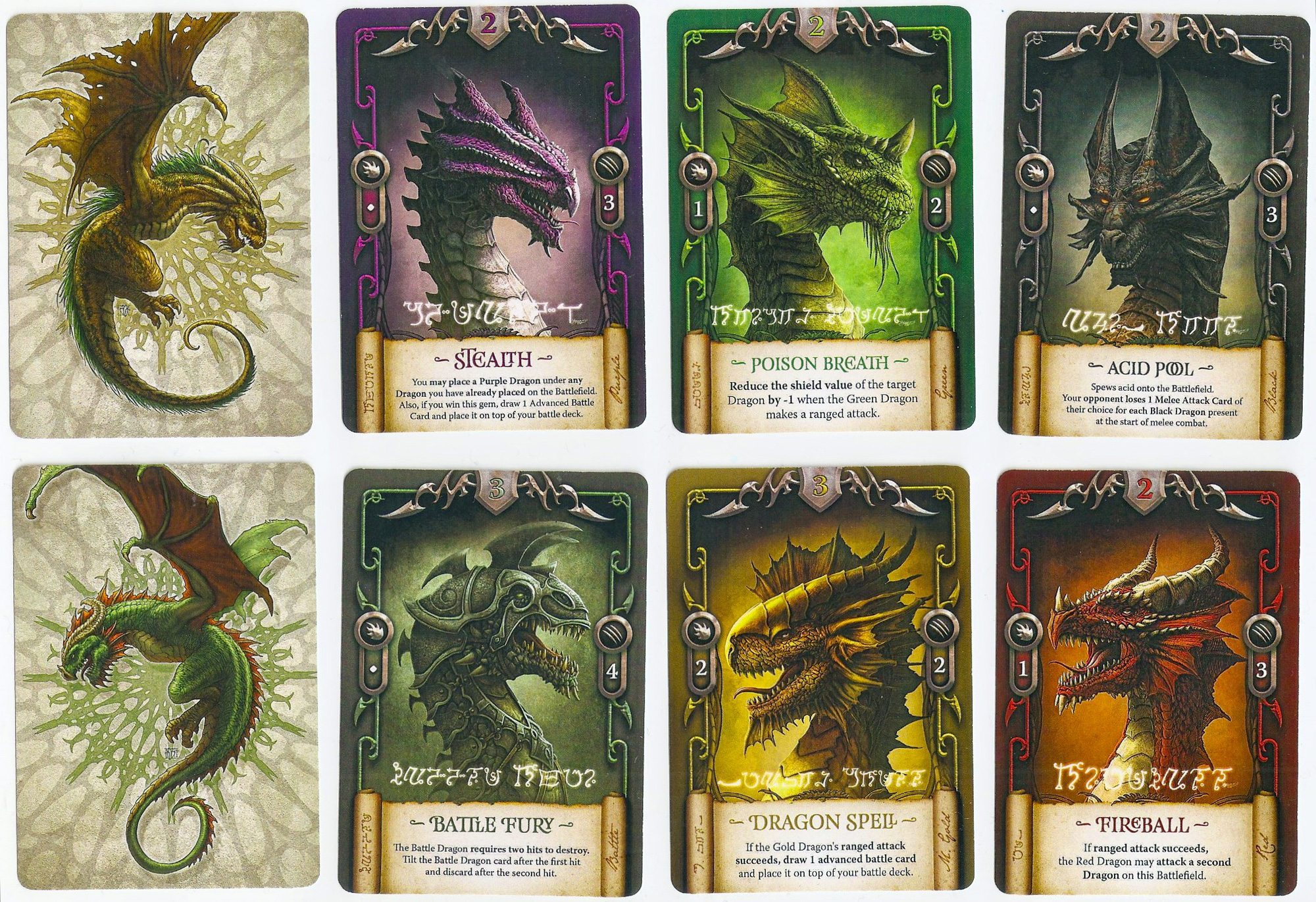
You start by sending dragons to the battlefields, at which point some dragons can make ranged attacks. These are resolved by flipping a number Battle cards from your deck based on your ranged attack value or your defense value: compare the number of starbursts on the appropriate sides of the card. If the attacker gets a higher number, then the defender loses the dragon.
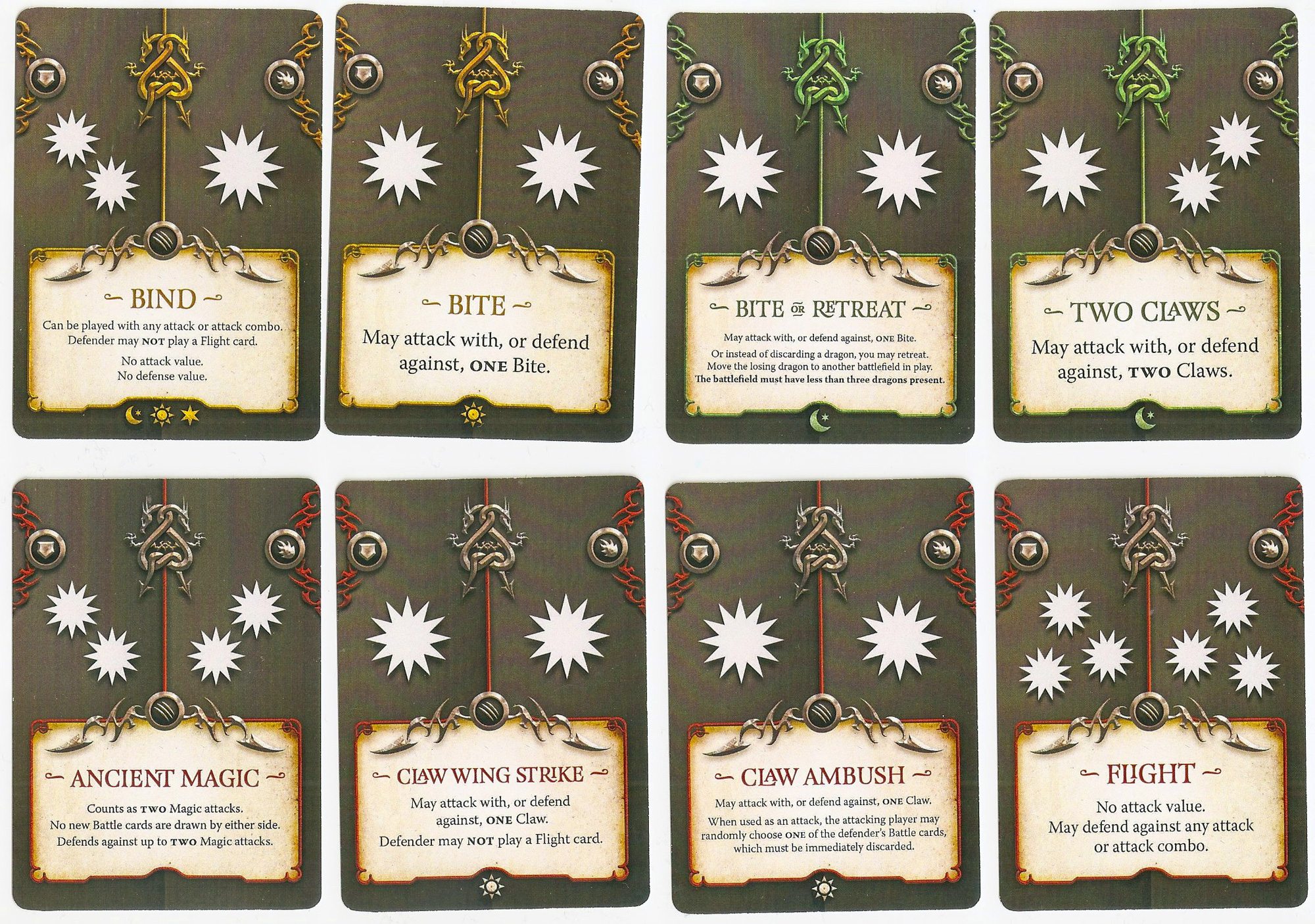
Some dragons have other specific abilities that come into play, and battlefields can also grant bonuses or penalties. Once everyone is done sending out their dragons (up to three of your dragons per location), then it’s time for the Melee phase.
After selecting a battlefield, you each draw Battle cards equal to the Melee values of your dragons at that location. Then you take turns as attacker and defender, playing Battle cards to defeat your opponent’s dragons at that location. You can play any number of attack cards, as long as the little icon at the bottom (sun, moon, star) matches. The defender then must play any number of cards (symbols do not have to match) to fend off your bites, claws, and magic attacks. For each attack card that does not get blocked, the defender loses a dragon.
If you eliminate all your opponent’s dragons or if you have more dragons at the battlefield after everyone is out of attacks to play, then you win the battlefield card. If, at the end of the melee battle, you’re both tied for number of dragons, then the battlefield and any surviving dragons stay there for the next round. The Melee phase continues (with players alternating as first player) until all battlefields with dragons have been resolved.
At the end of the round, you get a new Advanced Battle card, shuffle all of your Battle cards together, and draw back up to eight dragons for the next round. Battlefields are replenished so there are three available, and the fight continues.
Once somebody has the right mix of gems, the game ends immediately.
The Verdict
I’ve played several rounds of Draco Magi with different opponents, and it’s a pretty cool little game. The rulebook and text on the cards could be a little more clear, but I know they’re working on putting more details and fixing things that can be ambiguous. One of my biggest complaints, about the arrangement of the ranged/defense/melee areas of the cards, will be fixed in the final game as well.
The strategy of the game comes in a mix of ways. First, there’s the question of which gems to fight for. With eight dragons and three battlefields at a time, you’re always going to be short-handed at one of them, and the question is whether to focus all your firepower (so to speak) on two of them and let your opponent take the third gem easily, or spread yourself out and hope you don’t spread yourself too thin.
The ranged attacks which happen while you’re both placing dragons can be a great boon if they succeed, but I found it was often pretty difficult to achieve—you have to get more starbursts on your flipped cards than the defender, and most of the dragons only give you one or two cards for ranged attacks, against 2 or 3 cards for defenders. Battlefield bonuses and penalties can change the outcome of these attacks, though, so strategic placement of your dragons is very useful.
Once you get to the melee attacks, there’s a different set of strategy that comes into play. You have a limited number of cards—do you combine several of them for a big attack, or save them for defense? The Flight card allows you to defend yourself from an entire attack—no matter how many cards—with just a single card. However, there are a couple of attacks (and one Battlefield) which prevent you from flying, so if you were counting on a couple of Flight cards for your defense you can quickly find yourself crippled.
The Magic attacks are interesting, too—they allow both the attacker and the defender to draw back as many cards as they played for this attack. If you use Flight as a defense there, you’ll only get to draw one cards whereas the attacker might have played a three or four card combo. But if you play multiple cards to defend (and therefore draw more cards), you might not be able to fend off each attack, and thus lose a dragon.
Each player also has a Reinforce and a Retreat. Reinforce allows you to bring over a dragon from another battlefield when one of your dragons is defeated; Retreat lets you send the defeated dragon to another battlefield that isn’t full. Both let you manipulate your odds a little, giving up ground in one place to strengthen your position somewhere else.
I do hope that the game doesn’t end up in an enormous box, because it could be an extremely portable game if it’s packaged right. The rulebook could use some more clarifications of specific cards, and if they make the text a little larger on the cards it would be easier to read at a glance without squinting.
Overall, I’m pretty pleased with what I’ve seen. I like that it’s strictly a card game but has several different ways that the cards are used, and although it plays fairly quickly it does allow for some fun strategy. If you’re looking for a good two-player card game and you like cool illustrations of dragons, watch for the Draco Magi Kickstarter campaign soon!
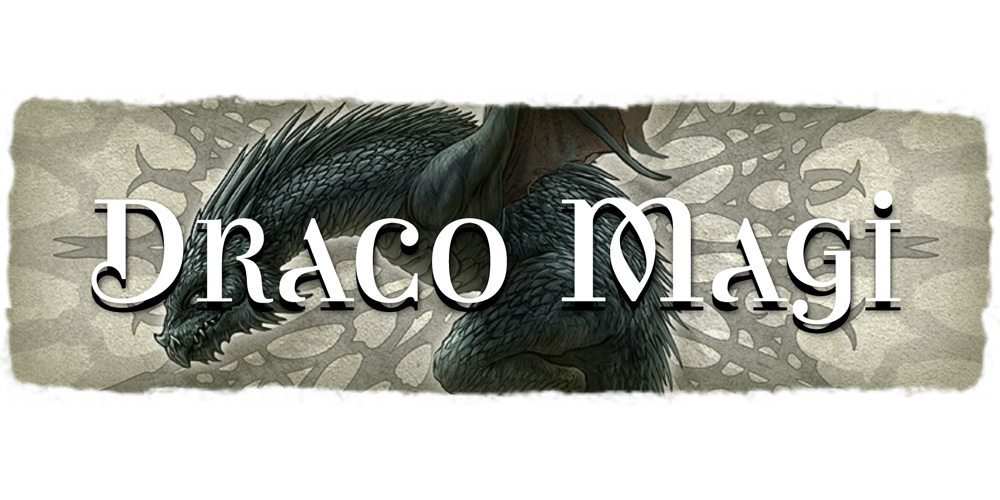

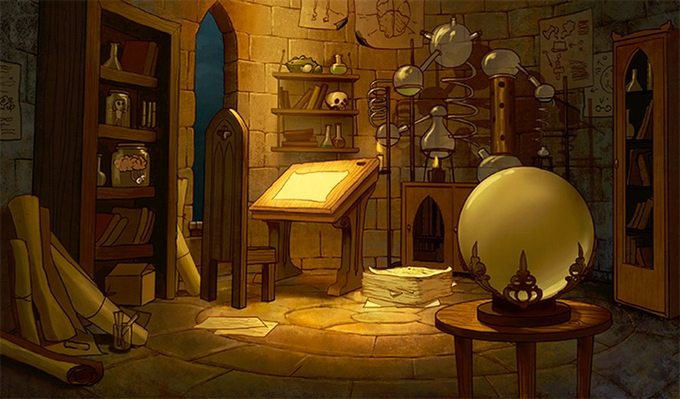
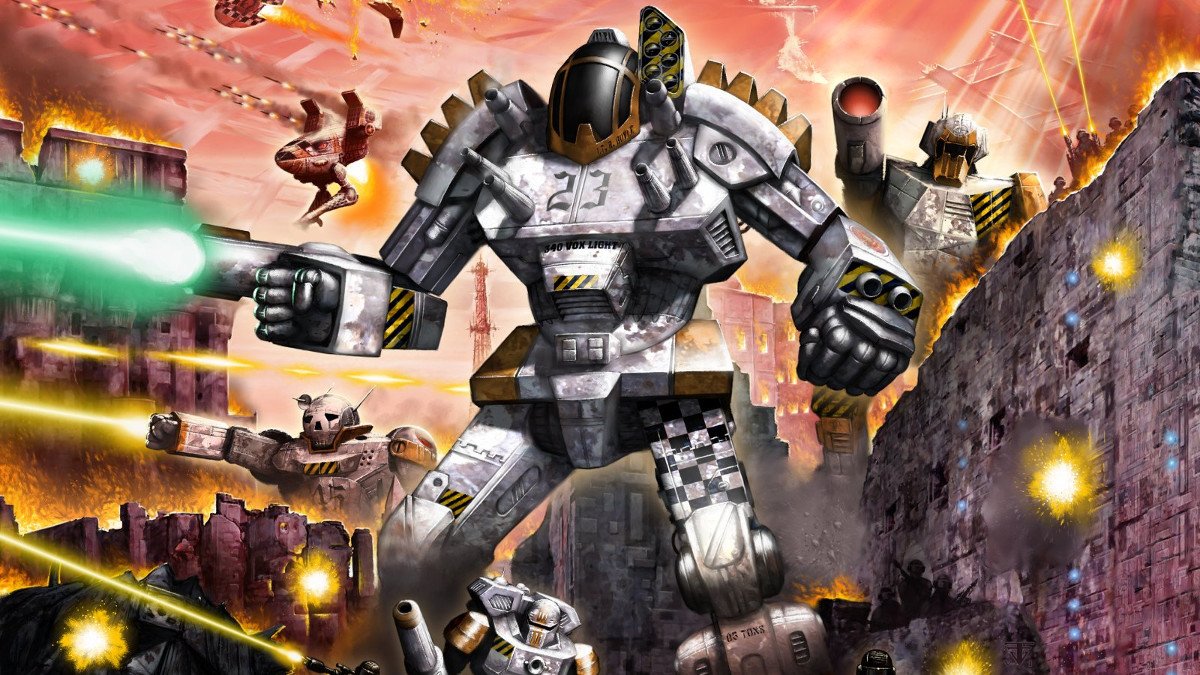
Looking forward to this series Johnathan. My wife and I are always looking for two player games that are worth our time. Good two player games are tough to come by and you’re right – portable and small play area are always a bonus for the two player scene.
thanks,
PS